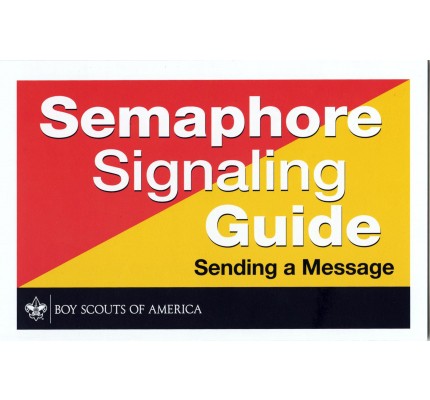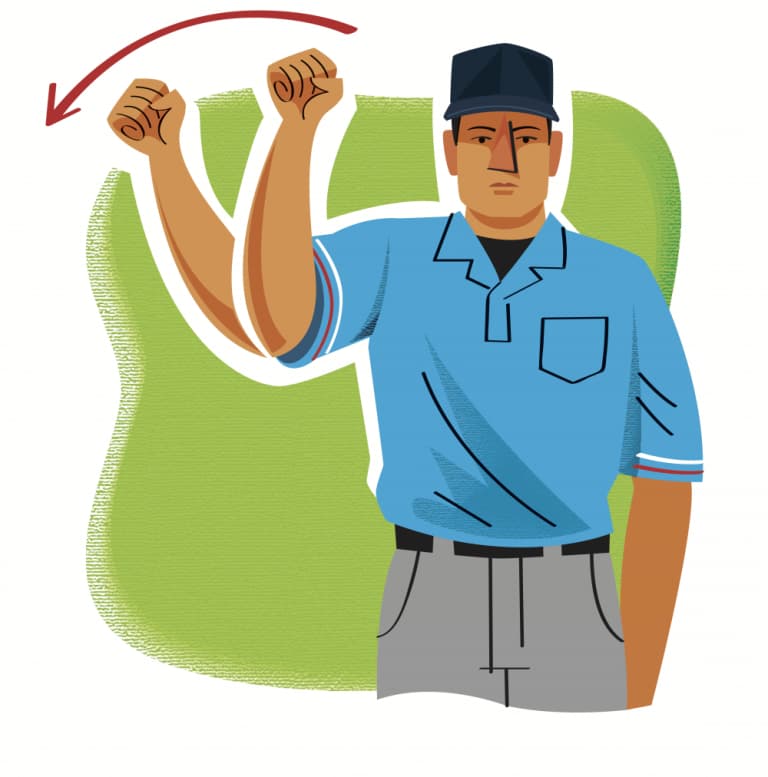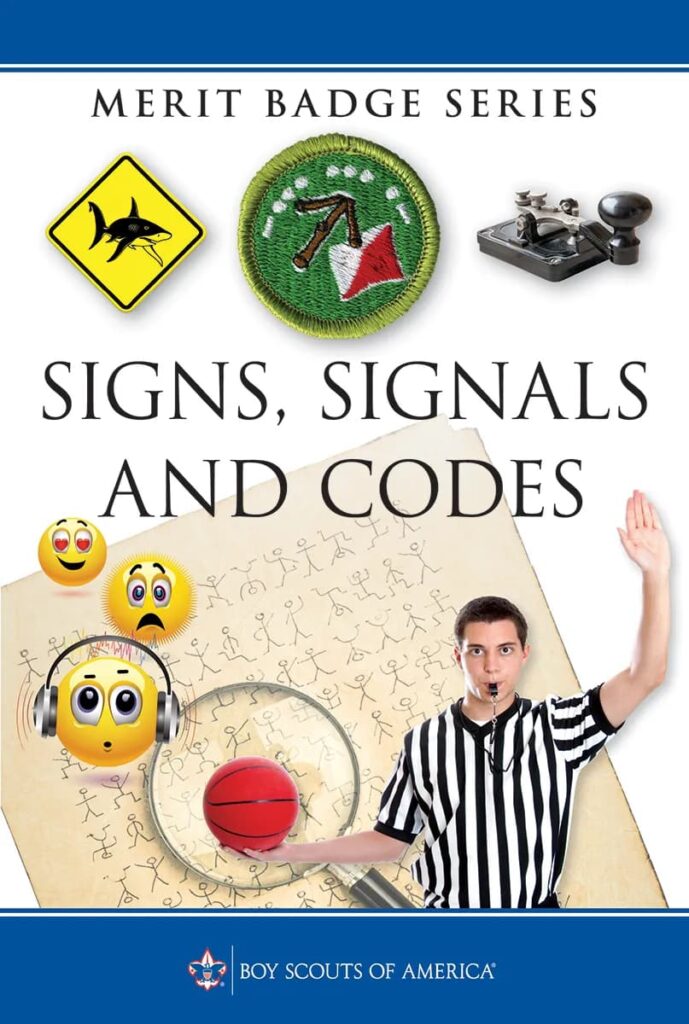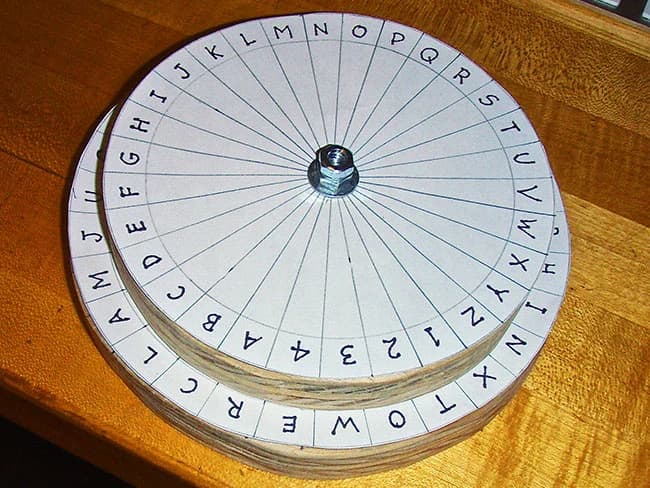Signs, Signals, and Codes Merit Badge
Signs, Signals, and Codes
Merit Badge
Scouting America Merit Badge Hub
Scouting America
Merit Badge Hub
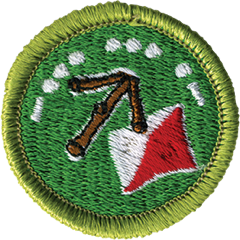
Signs, Signals, and Codes Merit Badge Overview
The Signs, Signals and Codes merit badge covers a number of the nonverbal ways we communicate: emergency signaling, Morse code, American Sign Language, braille, trail signs, sports officiating hand signals, traffic signs, secret codes and more.
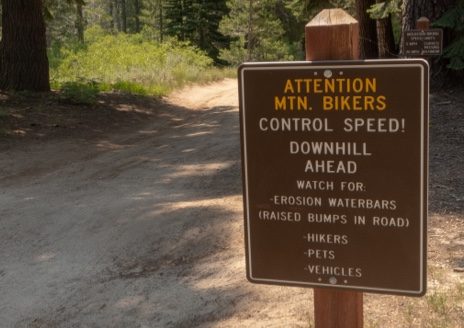
Signs, Signals, and Codes Merit Badge Requirements
The previous version of the Merit Badge requirements can be found in Scoutbook
The requirements will be fed dynamically using the scout book integration
1. Discuss with your counselor the importance of signs, signals, and codes, and why people need these different methods of communication. Briefly discuss the history and development of signs, signals, and codes.
2. Explain the importance of signaling in emergency communications. Discuss with your counselor the types of emergency or distress signals one might use to attract airborne search-and-rescue personnel if lost in the outdoors or trying to summon assistance during a disaster. Illustrate these signalling examples by the use of photos or drawings.
3. Do the following:
- (a) Describe what Morse code is and the various means by which it can be sent. Spell your first name using Morse code. Send or receive a message of six to 10 words using Morse code.
- (b) Describe what American Sign Language (ASL) is and how it is used today. Spell your first name using American Sign Language. Send or receive a message of six to 10 words using ASL.
4. Give your counselor a brief explanation about semaphore, why it is used, how it is used, and where it is used. Explain the difference between semaphore flags and nautical flags. Then do the following:
- (a) Spell your first name using semaphore. Send or receive a message of six to 10 words using semaphore.
- (b) Using illustrations or photographs, identify 10 examples of nautical flags and discuss their importance.
5. Explain the braille reading technique and how it helps individuals with sight impairment to communicate. Then do the following:
- (a) Either by sight or by touch, identify the letters of the braille alphabet that spell your name. By sight or touch, decode a braille message at least six words long.
- (b) Create a message in braille at least six words long, and share this with your counselor.
6. Do the following:
- (a) Describe to your counselor six sound-only signals that are in use today. Discuss the pros and cons of using sound signals versus other types of signals.
- (b) Demonstrate to your counselor six different silent Scout signals. Use these Scout signals to direct the movements and actions to direct the movements and actions of your patrol or troop.
7. On a Scout outing, lay out a trail for your patrol or troop to follow. Cover at least one mile in distance and use at least six different trail signs and markers. After the Scouts have completed the trail, follow the Leave No Trace Seven Principles and the Outdoor Code by replacing or returning trail markers to their original locations.
8. For THREE of the following activities, demonstrate five signals each. Tell what the signals mean and why they are used:
- (a) Sports official's hand signs/signals
- (b) Heavy-equipment operator's hand signals
- (c) Aircraft carrier catapult crew signals
- (d) Cyclist's hand signals
- (e) An activity selected by you and your counselor.
9. Share with your counselor 10 examples of symbols used in everyday life. Design your own symbol. Share it with your counselor and explain what it means. Then do the following:
- (a) Show examples of 10 traffic signs and explain their meaning.
- (b) Using a topographical map, explain what a map legend is and discuss its importance. Point out 10 map symbols and explain the meaning of each.
- (c) Discuss text-message symbols and why they are commonly used. Give examples of your favorite 10 text symbols or emoticons. Then see if your parent, guardian or counselor can identify the meaning or usage of each symbol.
10. Briefly discuss the history of secret code writing (cryptography). Make up your own secret code and write a message of up to 25 words using this code. Share the message with a friend or fellow Scout. Then share the message and code key with your counselor and discuss the effectiveness of your code.

Get the Signs, Signals, and Codes Merit Badge Pamphlet
Signs Signals Codes Merit Badge Emblem.

Shop Signs, Signals, and Codes Merit Badge Products
As the exclusive retailer of the BSA, 35% of every Scout Shop purchase supports the future of Scouting.
Discover more about "Signs, Signals, and Codes"

Baseball fans can get loud. Sometimes, they get really loud. That’s why umpires (the officials in baseball) use hand signals. That way, the players, coaches, fans in the stands and fans watching TV all know what’s happening. An umpire’s job is to make sure both teams are playing by the rules. The home-plate umpire is in charge. He makes all the calls at home plate, like balls and strikes. He also wears a mask and other padding to stay safe. The umpires at first base, second base and third base make the calls at their positions and in the outfield. Read on to learn some of the most important umpire signals. Plus, learning these signals will help Webelos fulfill one requirement of the Sportsman elective adventure. Here are the seven most common signals used by baseball umpires:
Out/Strike
Strikes are called with the right hand. Some umpires point to the side; others make a clenched fist. The “out” call — also a clenched fist — is used after a third strike or when a runner is out before reaching a base. Timeout/Foul Ball
Used when a batter hits a foul ball or when play must be paused. Foul Tip
Used when a batter swings and just barely tips the ball but the catcher still catches it. Do Not Pitch
Used to signal the pitcher to wait before throwing his next pitch. Safe
Used when a runner safely reaches any base. Play Ball
Used to signal the pitcher that it is OK to throw the pitch. Fair Ball
Used when a batter hits a ball that lands in fair ground. This signal can be made with either hand. With these seven signals in mind, you’ll understand the most common calls in baseball. But there are other signals umpires use during a game to communicate with players, coaches, scorekeepers and other umpires. Help us keep this list going by describing other signals an umpire uses by commenting below.
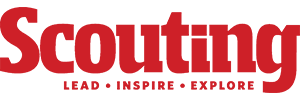
American Sign Language has its own grammar, syntax and dialects. Wigwag and semaphore both use flags but are completely different systems of communication. Deck crews on aircraft carriers use a number of hand signals to communicate with pilots and each other. Generally speaking, the more sides a traffic sign has, the more critical its message. That’s just some of what Scouts will learn as they pursue the new Signs, Signals and Codes merit badge, which debuted last February. As the name implies, the badge covers a huge range of nonverbal communications techniques, from smoke signals to emoticons. Eagle Scout Tim Malaney of Chula Vista, Calif., who chaired the team that created the badge, says the goal is not so much to develop proficiency as it is to whet Scouts’ appetites to learn more. “If you have an interest, you can go further,” he says. The emphasis on awareness over proficiency is a change from the Signaling merit badge, which was discontinued in 1991. To earn that badge in the 1940s, for example, Scouts had to send and receive Morse code at 35 letters per minute and semaphore signals at 30 letters per minute. What’s Covered?
Signs, Signals and Codes covers a broad array of topics, including emergency communications, Morse code, American Sign Language, semaphore, Braille, trail signs, silent signals of all sorts, traffic signs, map symbols, emoticons and cryptography. While Scouts don’t have to show proficiency, they do have to use each form of communication; for several requirements, they must both read and create short messages. “I think there’s a lot of opportunity for having fun,” Malaney says. The badge also covers the history of communication. Scouts might be surprised to learn that before the introduction of the radio telegraph, “everything for communicating was line of sight,” Malaney says. For example, the ancient Greeks used chains of message beacons to communicate across long distances. The first “télégramme” was sent in 1794 in much the same manner, using an early form of semaphore. How to Find Counselors
Given the broad range of topics the badge covers, Malaney acknowledges that it could be difficult to find expert merit badge counselors. One option, he says, is to identify a counselor with expertise in one area who could then educate herself about the other topics. Possibilities include ham radio operators, military personnel or teachers who know American Sign Language or Braille. Another option would be to create a round-robin format in which Scouts work with several adults in different subject areas. “This badge lends itself to group instruction — with the group being a group of counselors,” Malaney says. (Note that the Guide to Advancement allows for “guest experts” who are not registered as merit badge counselors to assist in instruction; see section 7.0.3.2.) Malaney also recommends that every counselor (and Scout) read the merit badge pamphlet cover to cover. “The editors did a great job,” he says. “I think the book’s easy to read and actually pretty fascinating.”

Writing secret messages is easy with this cipher wheel. It scrambles the alphabet so nobody can read your message except your buddy with an identical wheel. Armies once used similar devices because they could easily change the secret code. cipher-feature
WHAT YOU’LL NEED
2 pieces of plywood, 1/2″ x 8″ x 8″
1/4″ machine bolt, 1 1/2″ long
4 1/4″ flat washers
2 1/4″ nuts
Medium-grade sandpaper
Coping saw
Crosscut saw
Drill
1/4″ drill bit
Drawing compass
Protractor
Straight edge
Dark pen
WHAT YOU’LL DO
cipher-1Step 1: Use the compass to draw a 6″ circle on one piece of wood. Draw a 7″ circle on the second piece of wood.
cipher-2Step 2: With the coping saw, cut out both circles. Sand smooth.
cipher-3Step 3: Use the straight edge to draw one line all the way across each disc, making sure the line goes through the center of both plywood circles.
cipher-4Step 4: Center the protractor on the lines you just drew and make a mark every 12 degrees halfway around each disc.
cipher-5Step 5: Draw a line through each mark, across the center of both discs.
cipher-6Step 6: Staying within 1/2″ of the edge of the 7″ wheel, write this scrambled alphabet, one letter in each space: S P H I N X T O W E R C L A M J U G B D F K Q V Y Z. In the leftover spaces, write 5, 6, 7, 8. On the 6″ wheel, write the alphabet in regular order (A B C …). In the leftover spaces, write 1, 2, 3, 4.
cipher-7Step 7: Drill a 1/4″ hole through the center of each disc. Assemble the cipher wheel by putting one washer on the bolt. Put the bolt and washer through the bottom of the 7″ wheel. Turn the wheel over so the letters are facing up. Put two washers on the bolt, then add the 6″ wheel. Place another washer on the bolt and two nuts hand tightened so the wheels are snug and turn smoothly.
cipherwheel-550 HOW TO USE YOUR CIPHER WHEEL
Pick any letter on the outer wheel as your key letter. Turn the inner wheel so A lines up with the key letter. Next, find the first letter of your message on the inner wheel. Look at the letter or number above it on the outer wheel. Write this down. Do the same for each letter of your message. Example: Use the key letter R. Use the message SCOUT LAW. The enciphered message should be 7LYS8KRH. You can pick a different key letter for each message.


